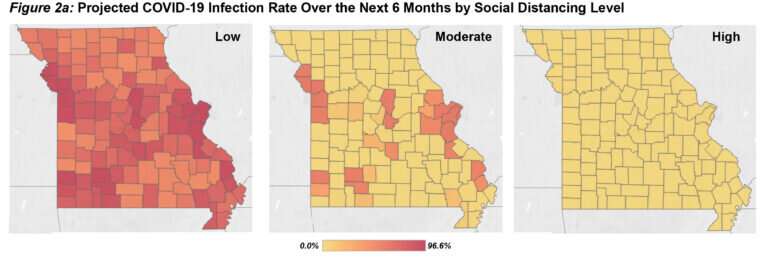Credit: Washington University in St. Louis
High levels of social distancing would lower the COVID-19 infection, hospitalization and death rates over the next six months across all counties in Missouri, finds a new study from Washington University in St. Louis.
Although death rates will be lower than in urban areas due to lower population density, rural areas will see significant numbers of hospitalizations and deaths from COVID-19. In all regions, projections are impacted by the local levels of social distancing, the study's authors wrote in a recently released paper.
"Our analysis illustrates that greater levels of social distancing will lead to lower rates of COVID-19 infection, hospitalization and death over the next six months throughout Missouri," said Abigail Barker, research assistant professor at the Brown School and faculty lead for data and methods at the university's Center for Health Economics and Policy at the Institute for Public Health (CHEP). She is lead author of the CHEP policy brief "High Levels of Social Distancing Lower the Projected Impact of COVID-19 in Missouri."
"For example, with low social distancing, St. Louis County, with a population of 998,684 people, is projected to have 901,386 infections over the next six months, a 90.2% infection rate," Barker wrote. "However, that number is reduced dramatically to 8,481 infections with high social distancing, or a 0.8% infection rate."
The model that Barker and her colleagues built predicts that the overall rates of COVID-19 infection, hospitalization and death will be lower for rural areas than for urban areas over the next six months.
"However, we expect to see higher rates of hospitalization and death in rural areas among those infected, based on the age distribution and health of rural Missouri residents," she said.
"Regardless of population size, all counties will see significant drops in the number of infections, hospitalizations and deaths when social distancing is high," Barker wrote. "Net changes in numbers will be larger for urban areas due to higher population counts, but rural areas may see higher relative decreases. Further, unlike urban areas, rural areas' projections suggest cases could drop to zero with robust social distancing measures, due to the lower baseline spread of disease in the setting of lower population density."
While the findings support social distancing to limit the spread and impact of COVID-19 in the state, higher levels of social distancing may lead to economic and social costs and it is unclear the amount of time a high level of social distancing will be needed to protect the health of Missourians.
"Areas with greater proportions of older individuals and people with chronic conditions face greater risks due to COVID-19—and benefit more from social distancing—than other areas," Barker said. "High levels of social distancing will lower the projected number of infections and hospitalizations, preventing hospitals from exceeding their maximum capacity, which would affect their ability to care for patients."
In particular, she said, this could help reduce the burden in rural areas, which have fewer hospital beds and other resources, and would therefore be disproportionately burdened by an uncontrolled COVID-19 caseload.
The brief is accompanied by an interactive data visualization that is updated weekly with the latest data.
Provided by Washington University in St. Louis























